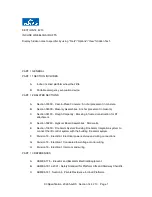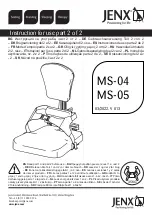
16
English
4 Flashes - right (M2) motor
As above but for the M2-connection.
5 Flashes - left (M1) parking brake
This indicates a break or a short circuit on the wire from the electronics module M1 connection to
the parking brake, alternatively a parking brake error. Control by unplugging the M1 connection and
measure the resistance between the inner pins (2 and 3), to determine a brake or a short circuit. Also
make sure that the decoupling control of the parking brake restores the brakes when the lever is
moved to drive mode.
6 Flashes - right (M2) parking brake
As above, but for the M2 connection.
7 Flashes - low battery voltage
Indicates that the battery voltage is too low to drive the wheelchair. Charge the battery and make
sure that the control light of the charger indicates charging. If the error remains, measure the battery
voltage both during and without charging connected. If there is a large difference between the volt-
age the batteries are probably bad and needs to be replaced. Also control the connections and cables
of the batteries.
8 Flashes - High battery voltage
This indicates that the battery voltage excess 32V. Normally this can only occur during charging and
indicates that the charger is faulty.
9 Flashes - CANL error
Indication on a disturbance (brake or short circuit in a CANl wire in the DX bus, which leads to com-
munication disorders between maneuver box and the electronics unit. The drive system will continue
to work in “spare drive mode” and the fault should be identified and be corrected as soon as possible.
The most probable cause to the error is a damaged bus cable between the maneuver box and the
electronics unit.
10 Flashes - CANH error
The CANH- wire in the DX bus is used partly for communication between electronics modules, partly
as a wire for a “KILL” signal. the KILL signal is a call to all modules to move over to a predetermined
safety mode. The signal is initiated by a connection between a CANH- wire to battery (+) or battery
(-). The signal can be given manually e.g. through an emergency switch, or be given automatically
from a module who detects an error an turns off the system. This means that a CANH- error can be
caused by various problems. the DX-system will if possible switch to “spare drive mode”.
11 Flashes - overload
If the motor current continually exceeds the pre- programmed limit during the time programmed as
“stall time out”, the wheelchair will stop and the controllight will flash 11 times. To reset the wheel-
chair it needs to be turned off and then on again.
12 Blink - compability error
This indicates a compability error between different ellectronics modules in the DX- system. This er-
ror cannot occur on a wheelchair adrift.
Service of the DX- system.
All cables and connectors should be checked regularly for damage and potential oxidation. Loose,
oxidated connectors or cables should be replaced.
All compoonents in the DX-system should be kept clean and free from dust, dirt and liquids. The
cleaning should be done with a cloth moistened in hot water or disinfectant. Do not use any solvents.
There are no parts in the system that needs service. Do not open any of the electronics boxes.
Warning! If any part in the system is damaged or if inner damages are suspected,
the components needs to be controlled by authorized personell before the wheel
chair can continue to be operated.





































